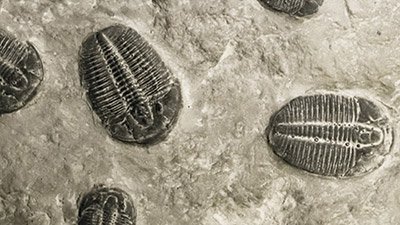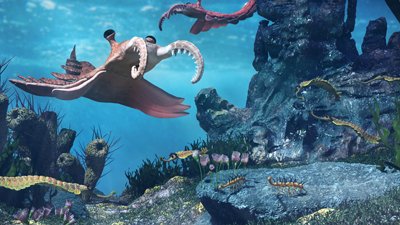Where Are All the Bunny Fossils?
If most of the fossil record was laid down all at once by the global Flood, then why are rabbits found only in “recent” Tertiary and Quaternary sediments?
An earlier version of this article incorrectly downplayed the latest young-earth creationist thinking on the extent of order in the fossil record. We apologize for that error and for the delay in publishing this emended version.

Does this detailed order exist in the fossil record? (Illustration from Gary Parker, Creation: Facts of Life, 3.8 How Fast?)
My friend asked me this question “find me a fossilised bunny in the cambrian or any equivalent...just one. thats all you would need.”
What would be a good response to that.
—M.L., USA
Thank you for passing along your friend’s question. So, where are all the bunny fossils?1 At first, it appears to be a riddle for creationists. The implication behind the question is that, if the fossil record isn’t an accurate record of millions of years of evolution, then why is there a neat order to it (see the illustration, right), which is explained by evolutionists as showing millions of years of slow burial? If most of the fossil record was laid down all at once by the global Flood, then why are rabbits found only in “recent” Tertiary and Quaternary sediments rather than in the sediments belonging to the “ancient” Cambrian period?
Fossils and the Geologic Column
We must first look at the very validity of the geologic column. Is there actually a definable Cambrian period that exists in the sedimentary layers, independent of uniformitarian and evolutionary presuppositions? Geologist Dr. Andrew A. Snelling answers:
Even though the order of strata and the fossils contained in them (sometimes extrapolated and interpolated) has been made the basis of the accepted millions-of-years system of geochronology and historical geology, the physical reality of the strata order and the contained fossils is generally not in dispute. . . . Careful correlations of strata of the same rock types have then been made between local areas and from region to region, often by physical means, so that the robustness of the overall fossil order and strata sequence of the geologic record has been clearly established.”2
So the geologic column isn’t simply an evolutionary fabrication; there is a definite general order in the fossil record. However, the schema isn’t quite as complete as the illustration on the right, nor does it accurately reflect a history of life. There are many known exceptions to the fossil record, such as living fossils,3 reworked fossils,4 and polystrate fossils5; indeed, the entire Cambrian explosion is one major puzzle to evolutionists.6
Considering the strict evolutionary/old-age interpretation of the fossil record, John Woodmorappe writes:
When we consider the fact that fossil succession is limited in overall extent, it is another way of stating that there are many fossils which are found at many stratigraphic intervals. In fact, only a minority are confined to rocks attributed to only one geologic period.
Since the early days of the acceptance of the standard geologic column, fossils have been turning up in “wrong” places as more and more fossils have been collected, and this process continues to this very day. And even this does not include the numerous instances where fossils are supposed to be reworked from older strata, often with no independent supporting evidence.7
Additionally, old-earthers use presuppositions about radiometric dating and uniformitarianism (the idea that present geological processes are the key to understanding the past) to interpret the fossil record.8
Even so, Snelling cautions, “[I]t is not the recognized order of the strata in the geologic record that is in dispute, but rather the millions-of-years interpretation for the deposition of the sedimentary strata and their contained fossils.”9 While there are facts contradictory to uniformitarian model that old-earthers have been hard-pressed to explain, there is nonetheless a clear overall order to the fossil record. So the question is, how do creationists explain why Cambrian sediments have no fossilized rabbits?
Alternative Explanations for Order
Let’s turn to Dr. Snelling to understand what degree of order we must explain. He writes, “The first fossils in the record are of marine animals exclusively, and it is only higher in the strata that fossils of land animals are found.” Why should this be? There’s actually a very obvious explanation within the global Flood model, and Dr. Snelling explains it: “[B]ecause the Flood began in the ocean basins (‘the fountains of the great deep burst open’) and the ocean waters then flooded over the continents.”10 In another article, he provides more detail, writing:
[The fossil record] can be more reasonably explained by Flood geologists as due to the order of burial of the different ecological zones of organisms by the Flood waters. For example, shallow marine organisms/ecological zones would be the first destroyed by the fountains of the great deep breaking open, with the erosional runoff from the land due to the torrential rainfall concurrently burying them.11
Creationist Gary Parker offers a general description of the model in Creation: Facts of Life (see the chapter 3.8 How Fast?):
[T]he geologic column does represent a tendency for fossils to be found in groups and for those groups to be found in a certain vertical order. Cambrian trilobites and Cretaceous dinosaurs aren’t usually found together. . . . Why aren’t trilobite and dinosaur fossils found together? According to evolution, the answer is easy. The Cambrian trilobites died out millions of years before the dinosaurs evolved. But there is another explanation that seems even more natural. After all, even if trilobites and dinosaurs were alive today, they still wouldn’t be found together. Why? Because they live in different ecological zones. Dinosaurs are land animals, but trilobites are bottom-dwelling sea creatures.
According to creationists, the geological systems represent different ecological zones, the buried remains of plants and animals that once lived together in the same environment. A walk through Grand Canyon, then, is not like a walk through evolutionary time; instead, it’s like a walk from the bottom of the ocean, across the tidal zone, over the shore, across the lowlands, and into the upland regions.12
Creationists have presented other reasons as well for the order in the fossil record. Many concern the way moving water sorts objects of different weight, density, and buoyancy. Others compare the mobility of such creatures as marine invertebrates (not very mobile) to humans and other mammals (much more mobile). The latter group would have generally been able to seek higher ground as the Floodwaters rose. Taken together, all these reasons can easily account for the order in the fossil record. We shouldn’t expect to find rabbit fossils in the Cambrian any more than we would expect to find rabbits today (dead or alive) on the ocean floor.
Conclusion
For more information, see our Fossils, Geology, and Living Fossils Get Answers sections.
I want to leave you with three key things to remember when it comes to interpreting the fossil record.
- Both creationists and evolutionists interpret the evidence in light of their presuppositions.
- Fossils aren’t the only reason we reject the old-earth model; there are geological reasons (such as missing geologic time), and, ultimately, we reject it because it disagrees with what the Bible says.
- For the young-earth creation model to be successful, we don’t have to destroy the old-earth model; we only have to understand how the facts fit what the Bible says. The creation model doesn’t rise or fall on how flawed the alternative is.
I hope this all helps. I also strongly recommend you read “Where Are All the Pre-Flood Human Fossils?” for another biblical perspective on order in the fossil record.
In Christ,
A. P. Galling
Footnotes
- This question, and this article’s title, are intended as a humorous reference toDr. Andrew A. Snelling’s seminal article Where are all the human fossils? The actual question the feedback submitter’s friend asked probably traces back to a purported quip of evolutionist J. B. S. Haldane, who said he would reject Darwinism if someone found a fossil rabbit in the Cambrian.
- A. Snelling, Doesn’t the Order of Fossils in the Rock Record Favor Long Ages? in K. Ham, ed., The New Answers Book 2 (Green Forest, AR: Master Books, 2008), 345. Snelling continues, “there are at least six thick sequences of fossil-bearing sedimentary strata, known as megasequences, which can be traced right across the North American continent and beyond to other continents. Such global-scale deposition of sediment layers . . . is, of course, totally inexplicable to uniformitarian (long-ages) geologists . . . . But it is powerful evidence of catastrophic deposition during the global Genesis flood.
- “Living” fossils are those that, based on the fossil record, were thought to have been extinct for millions of years but are actually still living among us today. A prime example is the coelacanth. A uniformitarian interpretation of the fossil record implies that the coelacanth evolved sometime before the age of the dinosaurs but went extinct around the same time the dinosaurs died out. In fact, that was the prevailing evolutionary wisdom for years—until coelacanths were found alive and well in modern oceans. See
- “Reworked” fossils describes fossils found so far from the layers they’re supposed to be in that evolutionists can’t reconcile the discrepancy. When out-of-place fossils are found, they are dismissed—or, more accurately, evolutionists create stories to explain why they are where they shouldn’t be.
- “Polystrate” fossils, such as tree trunks, cut vertically or semi-vertically through numerous layers claimed to be laid down millions of years apart. Uniformitarians usually have to resort to miniature catastrophes to explain polystratic fossils. For example, a TalkOrigins page on “Polystrate” Tree Fossils “counters” the young-earth model by saying, “This is not the correct way to do it, because individual beds can be deposited rapidly”!
- The Cambrian explosion is the most famous puzzle of the uniformitarian interpretation, when an extraordinary diversity of life-forms “explode” into the fossil record suddenly when nothing exists before. The scenario is at odds with the slow-and-gradual view Darwinists had previously maintained. To reconcile this puzzle with their worldview, famous evolutionist Stephen Jay Gould postulated the “punctuated equilibria” model that attempts to explain the fossil record by allowing sudden bursts of evolution followed by long periods of little transition.
- J. Woodmorappe, The fossil record: Becoming more random all the time, TJ 14(1):110–116, 2000.
- When it comes to radiometric dating, even the dating technique chosen for a given fossil is shaped by evolutionary assumptions; so is how much notice is paid to the margin of error and contradictory results given by other dates.
- A. Snelling, Doesn’t the Order of Fossils in the Rock Record Favor Long Ages? 346.
- A. Snelling, Doesn’t the Order of Fossils in the Rock Record Favor Long Ages? 345.
- A. Snelling, Where are all the human fossils? Creation 14(1):28–33, 1991.
- G. Parker, Creation: Facts of Life (Green Forest, AR: Master Books, 2006), taken from the online chapter 3.8 How Fast?
Recommended Resources

Answers in Genesis is an apologetics ministry, dedicated to helping Christians defend their faith and proclaim the good news of Jesus Christ.
- Customer Service 800.778.3390
- Available Monday–Friday | 9 AM–5 PM ET
- © 2026 Answers in Genesis






